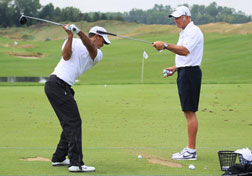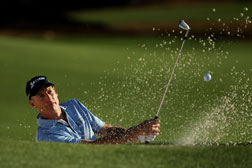Zen Golf vs. Moneygolf
Should the pros pay attention to statistics?
This series is available as an e-book for the Kindle. Download it today.
This isn't the first time that a new technology has descended upon golf, promising to change the game. In To the Linksland, * Michael Bamberger's 1992 book about caddying on the European tour, there's a passage in which Bamberger seeks the counsel of a wizened Scottish pro named John Stark. Here's the short version of their first encounter:
"Tell me what it is you seek to accomplish," John Stark said.
"I want to get better," I said quietly.
"You want to get better, a worthy goal," Stark said. "But what makes you think tuition is the way to improvement? I've seen many players ruined with instruction. I've seen instruction rob a player of all his natural instincts for the game."
Stark then begins a long monologue in which he dismisses American players as "outstanding golf robots" and argues that the fad for high-speed photography of golf swings corrupted the game in the 1950s: "It all seemed so obvious: there was a correct position for everything, all the points in the swing." But that was a false path. The game became too "technical" and the players lost their way.
In golf, there have always been those who side with "instincts" and those who side with analysis. I love the stories about 1920s professional golfer George Duncan, who would swing at his ball as soon as he reached it. He considered practice strokes tantamount to cheating. (Those early pros would also be amazed at how today's top players stalk the green for days to line up a putt.) In our time, the most instinctual golfer would be putting enthusiast Ryan Moore, who, at times, will disdain even to consult a yardage book.
When I talked to players on the PGA Tour—the alleged "golf robots"—I was surprised by how skittish they were about stats. Players certainly understand the importance of gaining a fractional advantage on the competition. When Phil Mickelson approached short-game guru Dave Pelz for help in 2003, Pelz was surprised that the game's pre-eminent player from short range would need his help. Mickelson's answer: "I want to be a quarter of a shot better per round in the majors." Most golfers don't seem to believe, though, that scrutinizing stats will get them the fractional gains they crave.
In my conversations with golfers, I would get a lot of staring at the ground once the word "ShotLink" came out of my mouth—as though I had mentioned Voldemort in the land of Harry Potter. Industrious pro Michael Letzig spoke for many of his peers when he said he never looks at his numbers during the season: "The stat is not going to change my swing." Letzig also had a touch of John Stark in him, telling me: "What's different from the people inside the ropes and the people outside the ropes is that, in here, golf is easier because we keep it simple." (True enough, Michael—though it's easier to keep it simple if you have transcendental talent.)
Several pros told me, in so many polite words, that they don't need a laser beam to tell them how far they hit their 5-iron. They play golf every day. How could they possibly be ignorant about their game? They can see what they need to do with their eyes.
This is the same prejudice that Bill James crusaded against in baseball—that the numbers can tell you what your lying eyes refuse to see. A golf game is actually hard to analyze. While I doubt most pros can recall their last 100 drives, ShotLink remembers them all. And you need to look at 100—or 200 or 500—drives to see whether you're losing fractions of a stroke. You don't even have to know the new stats I've been discussing to acquire useful insights. Golf consultant Mark Sweeney helps break down the ShotLink numbers for his pro clients. He told me of a player who, it was clear from the stats, was deficient with his 8-iron. All of his other iron play was good; the numbers revealed a blind spot.
I talked to a few players who had more favorable things to say about ShotLink. Brian Davis, an Englishman currently ranked 41st on the PGA Tour's money list, was the savviest pro I ran across. Davis says he looks at ShotLink every week and does a more in-depth analysis at the end of the season. He knows from ShotLink that he's lacking compared with others in driving distance, so he tries to "ramp it up" from the tee on holes where a long drive would clearly help. This is an ideal use of stats—a golfer using the numbers to fine-tune his strategy. He takes the risk of trying to really smoke a drive (and potentially end up in deep trouble) because the stats tell him he needs that distance to keep pace.
Davis also recognized that ShotLink has its limits: "You still need to play the game of golf." While it's nice to hit the green, "Sometimes you need to play away from the flag, or leave it short." Davis gave another example: "If I know that if I go over the green I'm dead, I might not mind if it lands 10 feet short of the green and I can just putt it up there."
Part of playing a golf course like a pro is knowing where to miss. There are good and bad places to find your ball, a fact that is lost on ShotLink. The intricacies of shot placement are not lost, however, by the most innovative golf stats. That's because the new stats are based on distance and location. The MIT putting study, for example, can identify the places on the green that are the most treacherous.
So, let's speculate about what it would mean if players genuinely knew where they stood in terms of driving, putting, and all the other facets of the game. The first and probably greatest benefit would come from using "moneygolf" to practice efficiently. The tour is filled with guys who show up, shoot 72-72, miss the cut, and go home. If the stats help you gain a few strokes on the other players, you'll stick around to play four days, finish in the money, and survive on the PGA Tour another year.
The big caveat to the use-stats-to-hone-your-practices theory is that moneygolf demonstrates the importance of the long game, and it's unclear whether you can really teach power. Some golfers have an innate ability to generate tremendous clubhead speed. A golfer can certainly work on his strength and flexibility and tailor his equipment, but short hitters don't transform themselves into long hitters. Plus, you are fighting age.
A second significant benefit for stat-savvy players would come from what Brian Davis is already doing: using moneygolf to strategize. A shot-value analysis of a player's last few tournaments would give a snapshot of what's working and what isn't. While moneygolf won't fix a broken swing, it could help a golfer think about how to play a given hole based on the current state of his game. It could also provide a psychological boost: If your chipping has been solid, you can be more aggressive on the approach, knowing that you've been recovering well from misses.
But here I've already crossed the bridge from statistics into a player's mind. Those of us "outside the ropes" can use moneygolf to better understand the game we love, but the players don't have that luxury. They succeed or fail stroke by stroke, hole by hole—each shot is taken in a pressure situation, one that commands a player to focus and, in the parlance of our time, "execute."
As I've written this series, I've been haunted by the conversation that I had with former U.S. Open champion Jim Furyk. I cornered Furyk as he walked off the driving range, starting in with my usual ShotLink spiel. He started, like many players had, by talking about how greens in regulation is a bogus stat. Then he stopped and looked at me.
"I don't look at that stuff," he said. Then he paused and said, "I know."
Another pause.
I'm kind of slow on the uptake: "Uh, what do you know?"
Furyk was gracious: "I know in my heart what I did on the course that day. If I don't have confidence when standing over a shot, I know that I need to go out and work on it."
He then stepped into a golf cart and drove away.
To hear Michael Agger, Josh Levin, Mike Pesca, and Hanna Rosin discuss Agger's "Moneygolf" series, click the arrow on the audio player below and fast-forward to the 16:35 mark:
You can also download the podcast, or you can subscribe to the weekly Hang Up and Listen podcast feed in iTunes.

